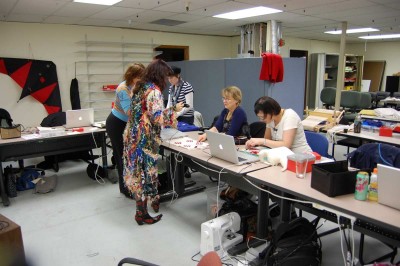Reposted from Hackerspace member Liz’s blog
The Path Not Taken
When I was a senior in high school I had plans to be a fashion designer. I earned some college credit in fashion attending the School of the Art Institute of Chicago one summer. I designed and made some of the clothes I wore. I applied and was accepted to attend the Fashion Institute of Technology in New York City.
Then I, well, I think perhaps, sort of chickened-out. Or maybe I just decided to explore some other things I liked first; I’ve always struggled with juggling multiple interests. I ended up studying math at a university in the same state I grew up in and then worked as an actuary for 14 years. Then I quit and the last couple years I’ve been teaching myself various programming languages and tools with the goal of transforming myself into a web developer.
This past weekend I got to experience a little taste of what it would have been like if I had stuck with plan A, mixed it with a bit of plan C, and added some seafood sensation and secret sauce.
I attended a 2-day workshop titled “Where Electronics Meet Textiles”, put on by award winning textile artist Lynne Bruning and Italian eTextile Master Troy Nachtigall. About 17 attendees from various backgrounds learned about the latest innovations, the materials and disciplines involved, and at the end we were left to our own devices, so to speak, making something of our own choosing (actually and thankfully we had a lot of help from Troy and Lynne!).

Lynne lending her expertise for our projects
At the heart of eTextiles, wearable computing, etc. is often a LilyPad, which is a smaller, more elegant-looking version of an Arduino. These devices are a combination of electronics hardware and programmable software that allow you to transform physical inputs into different physical outputs. Think things like light, motion, sound, contact, etc. Combine this with fabrics, conductive thread or other material, and various other electronics hardware and you can create clothes that light up in response to movement or sound, convert sound or proximity of other objects to vibration, monitor body processes like heart rate, sleep, etc.
Our instructors Lynne and Troy complemented each other well in their strengths and interests. We also had a special guest: Nwanua Elumeze, founder of Aniomagic, who is developing some really innovative ways of addressing human-machine interaction. For example: uploading information to your device by holding it up to your computer screen, where patterns of light, sound or movement are used to send the information, rather than messing about with cables and not-so-basic instructions.
As mentioned, the afternoon of the second day was spent on building our own projects. I don’t know whether to feel guilty about this or encouraged that my life choices of late are on the right track, but I didn’t actually make it to the integrating-with-the-fabric part. I was too captivated with programming my LilyPad. But my new friends made a variety of items, most of which involved some sort of blink and bling. You can see some of it here.
The event was sponsored by SparkFun Electronics and PlugandWear and held at SparkFun’s offices in Boulder.
I’m glad my path has come round again and I’ve met up with with these other eTextiles pioneers; perhaps together we can explore the interstitial spaces where we will create magic and the impossible.
More Links:
What’s an Arduino
Wit and Wonder’s story about the workshop
Good press lately for SparkFun


 January 20th, 2011
January 20th, 2011  admin
admin
 Posted in
Posted in  Tags:
Tags: